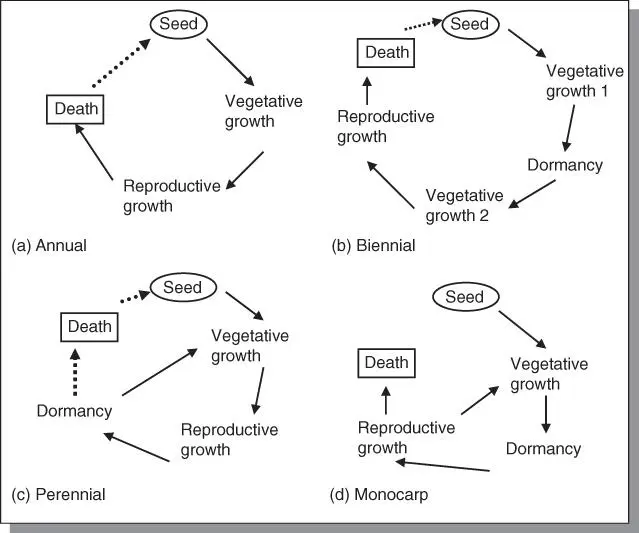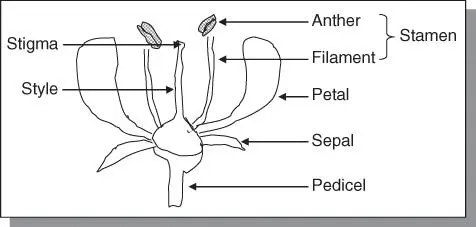In order for sexual reproduction to occur, two processes must occur in sexually reproducing species. The first process, meiosis, reduces the chromosome number of the diploid (2 n ) cell to the haploid ( n ) number. The second process, fertilization,unites the nuclei of two gametes, each with the haploid number of chromosomes, to form a diploid. In most plants, these processes divide the lifecycle of the plant into two distinct phases or generations, between which the plant alternates (called alternation of generation) ( Figure 5.1). The first phase or generation, called the gametophyte generation, begins with a haploid spore produced by meiosis. Cells derived from the gametophyte by mitosis are haploid. The multicellular gametophyte produces gametes by mitosis. The sexual reproductive process unites the gametes to produce a zygotethat begins the diploid sporophyte generationphase.

Figure 5.1Schematic representation of alternation of generations in flowering plants. The sporophyte generation is diploid, and often the more conspicuous phase of the plant lifecycle. The gametophyte is haploid.
In lower plants (mosses, liverworts), the sporophyte is small and dependent upon the gametophyte. However, in higher plants (ferns, gymnosperms, angiosperms), the male gametophyte generation is reduced to a tiny pollen tube and three haploid nuclei (called the microgametophyte). The female gametophyte (called the megagametophyte) is a single multi‐nucleated cell, also called the embryo sac. The genotype of the gametophyte or sporophyte influences sexual reproduction in species with self‐incompatibility problems. This has implications in the breeding of certain plants as discussed further in this chapter.
5.4.2 Duration of plant growth cycles
The plant breeder should know the lifecycle of the plant to be manipulated. The strategies for breeding are influenced by the duration of the plant growth cycle. Angiosperms (flowering plants) may be classified into four categories based on the duration of their growth cycle as follows ( Figure 5.2):
1 AnnualAnnual plants (or annuals) complete their lifecycle in one growing season. Examples of such plants include corn, wheat, and sorghum. Annuals may be further categorized into winter annuals or summer annuals. Winter annuals (e.g. wheat) utilize parts of two seasons. They are planted in fall and undergo a critical physiological inductive change called vernalization that is required for flowering and fruiting in spring. In cultivation, certain non‐annuals (e.g. cotton) are produced as though they were annuals.
2 BiennialA biennial completes its lifecycle in two growing seasons. In the first season, it produces basal roots and leaves; then it grows a stem, produces flowers and fruits, and dies in the second season. The plant usually requires a special environmental condition or treatment (e.g. vernalization) to be induced to enter the reproductive phase. For example, sugar beet grows vegetatively in the first season. In winter, it becomes vernalized and starts reproductive growth in spring.
3 PerennialPerennials are plants that have the ability to repeat their lifecycles indefinitely by circumventing the death stage. They may be herbaceous, as in species with underground vegetative structures called rhizomes (e.g. indiangrass), or aboveground structures called stolons (e.g. buffalograss). They may also be woody as in shrubs, vines (grape), and trees (orange).
4 MonocarpMonocarps are annuals or biennials, but some persist in vegetative development for very long periods of time (e.g. the so‐called “century plant”) before they flower and set seed (e.g. bamboo and agave). Once flowering occurs, the plant dies. That is, monocarps are plants that flower only once. Other examples are bromeliads. The top part dies, so that new plants arise from the root system of the old plant.

Figure 5.2Flowering plants have one of four lifecycles: annual, biennial, perennial, and monocarp. Variations occur within each of these categories, partly because of the work of plant breeders.
It should be pointed out that certain plants that may be natural biennials or perennials are cultivated by producers as annuals. For example, sugar beet, a biennial, is commercially produced as an annual for its roots. For breeding purposes, it is allowed to bolt to produce flowers for crossing, and subsequently to produce seed.
5.4.3 The flower structure
Genetic manipulation of flowering plants by conventional tools is accomplished through the technique of crossing, which involves flowers. To be successful, the plant breeder should be familiar with the flower structure, regarding the parts and their arrangement. Flower structure affects the way flowers are emasculated (prepared for crossing by removing the male parts to make the flower female). The size of the flower affects the kinds of tools and techniques that can be used for crossing.
5.4.4 General reproductive morphology
Four major parts of a flower are generally recognized – petal, sepal, stamen,and pistil. These form the basis of flower variation. Flowers vary in the color, size, numbers, and arrangement of these parts. Typically, a flower has a receptacle to which these parts are attached ( Figure 5.3). The male parts of the flower, the stamens, comprise a stalk called a filament,to which is attached a structure consisting of four pollen‐containing chambers that are fused together ( anther). The stamens are collectively called the androecium. The center of the flower is occupied by a pistil, which consists of the style, stigma, and ovary (contains carpels). The pistil is also called the gynoecium. Sepals are often leaf‐like structures that enclose the flower in its bud stage. Collectively, sepals are called the calyx. The showiest parts of the flower are the petals, collectively called the corolla.

Figure 5.3The typical flower has four basic parts: petals, sepals, pistil, and stamen. The shape, size, color, and other aspects of these floral parts differ widely among species.
When a flower has all the four major parts, it is said to be a complete flower(e.g. soybean, tomato, cotton, tobacco). However, if a flower lacks certain parts (often petals or sepals) as is the case in many grasses (e.g. rice, corn, wheat), it is said to be an incomplete flower. Some flowers either have only stamens or a pistil, but not both. When both stamens and a pistil occur in the same flower, the flower is said to be a perfect flower(bisexual), as in wheat, tomato, and soybean. Some flowers are unisexual (either stamens or pistil may be absent) and are called imperfect flowers. If imperfect flowers have stamens, they are called staminate flowers. When only a pistil occurs, the flower is a pistillate flower. A plant such as corn bears both staminate (tassel) and pistillate (silk) flowers on the same plant and is said to be a monoecious plant. However, in species such as asparagus, and papaya, plants may either be pistilliate (female plant) or staminate (male plant) and are said to be dioecious plants. Flowers may either be solitary(occur singly or alone) or may be grouped together to form an inflorescence. An inflorescence has a primary stalk (peduncle) and numerous secondary smaller stalks (pedicels). The most common inflorescence types in crop plants are the cyme and raceme. A branched raceme is called a panicle(e.g. oats) while a raceme with sessile (short pedicels) is called a spike(e.g. wheat). From the foregoing, it is clear that a plant breeder should know the specific characteristics of the flower in order to select the appropriate techniques for crossing.
Читать дальше















